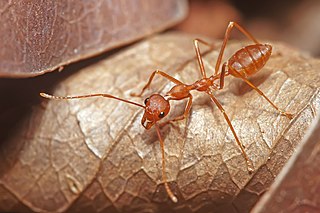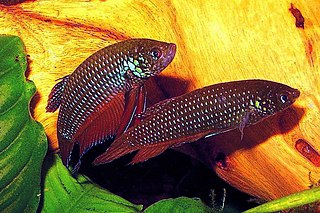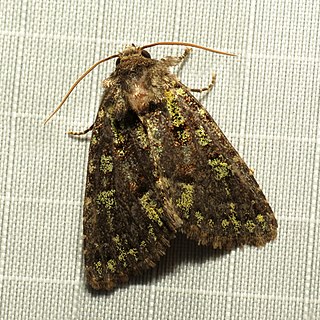
The Emerald Tablet, also known as the Smaragdine Tablet or the Tabula Smaragdina, is a compact and cryptic Hermetic text. It was highly regarded by Islamic and European alchemists as the foundation of their art. Though attributed to the legendary Hellenistic figure Hermes Trismegistus, the text of the Emerald Tablet first appears in a number of early medieval Arabic sources, the oldest of which dates to the late eighth or early ninth century. It was translated into Latin several times in the twelfth and thirteenth centuries. Numerous interpretations and commentaries followed.

Weaver ants or green ants are eusocial insects of the family Formicidae. Weaver ants live in trees and are known for their unique nest building behaviour where workers construct nests by weaving together leaves using larval silk. Colonies can be extremely large consisting of more than a hundred nests spanning numerous trees and containing more than half a million workers. Like many other ant species, weaver ants prey on small insects and supplement their diet with carbohydrate-rich honeydew excreted by small insects (Hemiptera). Weaver ant workers exhibit a clear bimodal size distribution, with almost no overlap between the size of the minor and major workers. The major workers are approximately 8–10 mm (0.31–0.39 in) in length and the minors approximately half the length of the majors. Major workers forage, defend, maintain, and expand the colony whereas minor workers tend to stay within the nests where they care for the brood and 'milk' scale insects in or close to the nests.

Oecophylla smaragdina is a species of arboreal ant found in tropical Asia and Australia. These ants form colonies with multiple nests in trees, each nest being made of leaves stitched together using the silk produced by the ant larvae: hence the name 'oecophylla' [Greek for 'leaf-house'].

Dhenkanal State was one of the princely states of India during the period of the British Raj. The state is now referred to as Dhenkanal district, Odisha, with Dhenkanal town as its district headquarters.

Cochlostyla smaragdina is a species of small, air-breathing land snails, terrestrial pulmonate gastropod mollusks, in the family Camaenidae endemic to the Philippines. The specific name "smaragdina" comes from "smaragdus," Latin for "emerald," and refers to the brilliant green of mature specimens. This name is commonly misspelled as "smargadina," an error which has propagated through multiple databases.

Betta smaragdina, commonly known as the emerald green betta, blue betta or Mekong fighting fish is a species of gourami native to Southeast Asia. The species gets its green and blue colors due to refraction and interference of light that results from hexagonal crystals that are less than 0.5 micrometres. It is found in the aquarium trade.

Luffa acutangula is a cucurbitaceous vine that is commercially grown for its unripe fruits as a vegetable. Mature fruits are used as natural cleaning sponges. Its fruit slightly resembles a cucumber or zucchini with ridges. It ranges from central and eastern Asia to southeastern Asia. It is also grown as a houseplant in places with colder climates. English common names include angled luffa, Chinese okra, dish cloth gourd, ridged gourd, sponge gourd, vegetable gourd, strainer vine, ribbed loofah, silky gourd, silk gourd,

Arhopala madytus, the bright oakblue, is a butterfly of the family Lycaenidae. The species was first described by Hans Fruhstorfer in 1914. It is found on New Guinea and adjacent islands and the north-east coast of Queensland, Australia.

Arhopala micale, the common oakblue or shining oakblue, is a butterfly of the family Lycaenidae. The species comprises about 16 subspecies, which are found in Melanesia and New Guinea as well as the north coast of Australia.

Trilochana is a genus of moths in the family Sesiidae.
Aldisa smaragdina is a species of sea slug, a dorid nudibranch, a marine gastropod mollusk in the family Cadlinidae.

Euliphyra mirifica, the African moth butterfly, is a butterfly in the family Lycaenidae. It is found in Ghana, Nigeria, Cameroon, Gabon, the Republic of the Congo, the Central African Republic, northern Angola and the western two-thirds of the Democratic Republic of the Congo. The habitat consists of forests.

Smaragdina is a genus of short-horned leaf beetles belonging to the family Chrysomelidae, subfamily Cryptocephalinae.
Potamocypris smaragdina is a species of ostracod crustacean in the family Cyprididae, subfamily Cypridopsinae. It is known from both Europe and North America.

Trilochana scolioides is a moth of the family Sesiidae. It is found in India (Darjeeling), Thailand and Vietnam.
De Alchemia is an early collection of alchemical writings first published by Johannes Petreius in Nuremberg in 1541. A second edition was published in Frankfurt in 1550 by the printer Cyriacus Jacobus.
The Chalukyas of Lata were an Indian dynasty, which ruled the Lata region of present-day Gujarat during 10th and 11th centuries. They ruled as feudatories of the Western Chalukyas in their early years, and were ultimately defeated by the Chaulukyas of Gujarat (Solankis).

Paramiana smaragdina is a species of moth in the family Noctuidae. It is found in North America.
Felicia smaragdina is an annual, bristly and glandular, much branched plant of up to 40 cm high, that has been assigned to the family Asteraceae. It has seated, slightly succulent, line-shaped leaves of up to 3 cm long and about 1 mm (0.04 in) wide. Its flower heads sit individually at the tip of the branches, and contain about twenty yellow ray florets of about 8 mm long and 11⁄2 mm (0.06 in) wide, surrounding many yellow disc florets. A unique character is that when dried, the florets become greenish. The species is an endemic species of Namibia.











